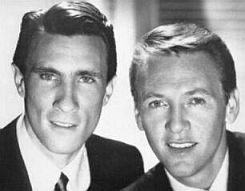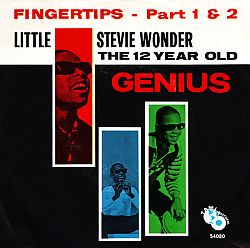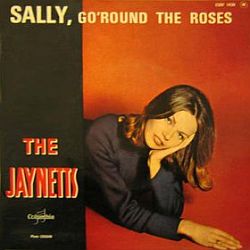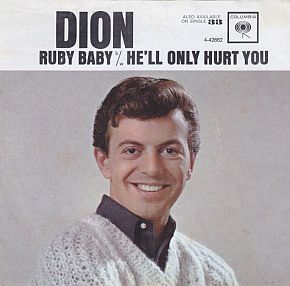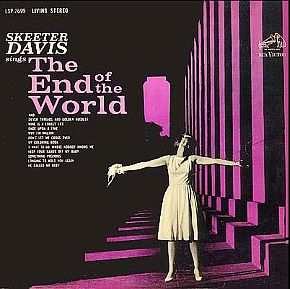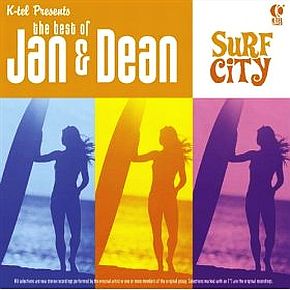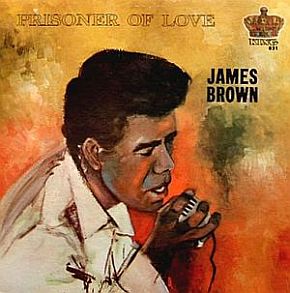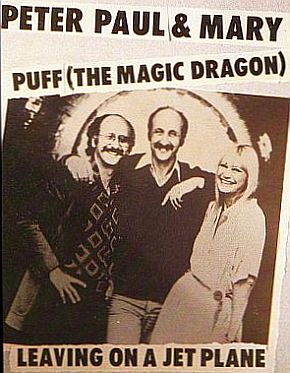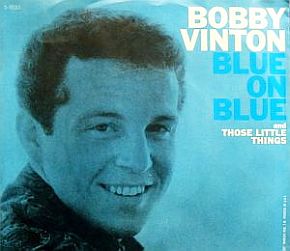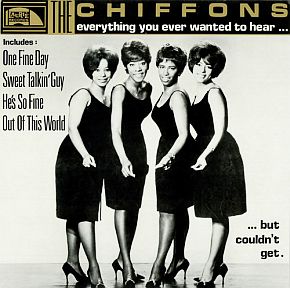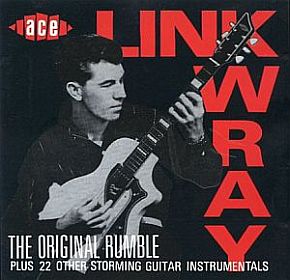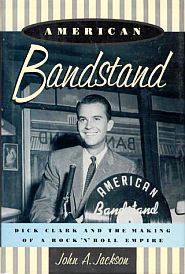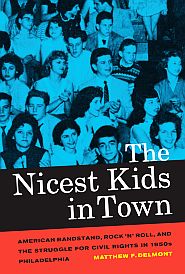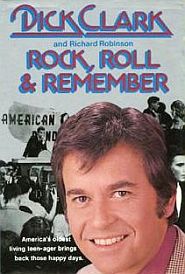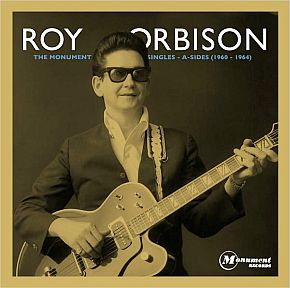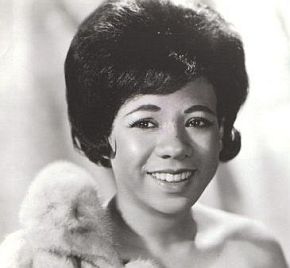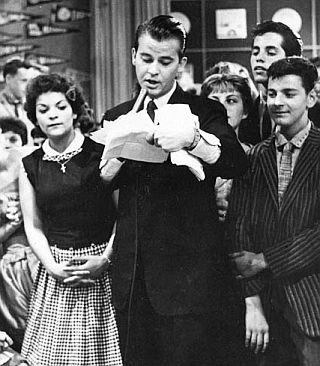
Dick Clark on the "American Bandstand" TV show from Philadelphia, appears with teens around him as he reads mail. AP photo.
During 1963, there were more than 200 guest appearances on American Bandstand, with a number of artists making their national television debuts. Among some of the more notable performers appearing in 1963 with one or more hit songs were: Dionne Warwick, Paul & Paula, the Ronettes, the Righteous Brothers, Peter Paul & Mary, Franki Valli & The Four Seasons, The Chiffons, Dion, Bobby Rydell, Skeeter Davis, Nancy Sinatra, Lesley Gore, Frankie Avalon, Gene Pitney, Dee Dee Sharp, Jan & Dean, Neil Sedaka, Darlene Love, Bobby Vinton, Link Wray, and others.
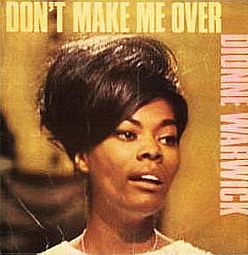
Cover sleeve for Dionne Warwick’s single, “Don't Make Me Over,” a hit song in 1962-63. Click for CD.
Warwick would follow this hit with others, including, “Anyone Who Had a Heart,” released in December 1963 and “Walk On By” in April 1964, a major international hit and million seller.
Dionne Warwick went on to stardom and a long career of many hits, including those in collaboration with the writer/producer team of Burt Bacharach and Hal David during the 1962 -1971 period. Warwick, in fact, would put 56 singles on the Billboard Hot 100 chart between 1962 and 1998, making her one of the that era’s leading female recording stars.
The Four Seasons, a quartet of singers from New Jersey with front man Franki Valli and his famous falsetto voice, appeared on American Bandstand at least twice in 1963. These “Jersey Boys” as they would come to be known years later from a famous stage production of that name, formed their group in 1960 as The Four Lovers. They eventually became The Four Seasons, with Frankie Valli on lead, Bob Gaudio keyboards and tenor vocals, Tommy DeVito on lead guitar and baritone vocals, and Nick Massi on bass guitar and bass vocals. By the time they appeared on American Bandstand in 1963, they were already stars, having released their first album in 1962 with the No. 1 hit single “Sherry,” followed by their second No. 1 hit, “Big Girls Don’t Cry” – both million-sellers. The Four Season appeared twice on Bandstand in 1963 – once in February and once in March – performing “Walk Like a Man” on both occasions. That song had been released in January 1963, but by March 2nd that year it had hit No. 1 on the Billboard Hot 100, remaining there for three weeks and in the Top 40 for 12 weeks. The Four Seasons would go on to become one of the more popular musical groups of that era, and for years thereafter, selling some 175 million records worldwide.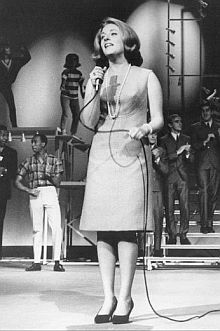
Lesley Gore, shown at 1964 TAMI concert, appeared on Bandstand, May 1963, singing “It’s My Party.” Click for 'Best of' CD.
But by June 1, 1963, after Gore made her national TV debut on Bandstand performing “It’s My Party,” the song shot to No. 1 on the pop charts, remaining there for two weeks. Gore would also have big subsequent follow-up hits, including “Judy’s Turn To Cry” and “You Don’t Own Me.” And years, later, she would also be nominated for an Oscar for co-writing the 1980 song, “Out Here On My Own” from the movie Fame.
The Righteous Brothers appeared on Bandstand in June 1963, but this was before their major stardom, coming at a time when they worked with a small recording company and then using the Moonglow label. Under that label, they produced two moderate hits: “Little Latin Lupe Lu” and “My Babe.” Their big hit – “You’ve Lost That Lovin’ Feelin,” produced with studio wizard Phil Spector – would not come until 1965.
Among others appearing on Bandstand in June of 1963, were: Frankie Avalon, Chubby Checker, Bobby Vinton, and Nancy Sinatra. James Brown also appeared that month performing his “Prisoner of Love,” as did Barbara Lewis with her hit, “Hello Stranger” and The Essex, with their hit,”Easier Said Than Done.” The Essex were an interesting group for that time, composed as they were of five U.S. Marines: Walter Vickers, Rodney Taylor, Billy Hill, Rudolph Johnson, and female Marine, Anita Humes. Stationed at Camp LeJeune in North Carolina, they cut a demo that landed them a contract with Roulette Records. Their hit song, “Easier Said Than Done,” was written by William Linton and Larry Huff, recorded by the group in 20 minutes, and released in May 1963. To the group’s surprise, it soared to No. 1 on the Billboard Hot 100 chart on July 6, sold more than one million copies, and garnered a gold disc from the recording industry. In September1963, The Essex had another hit, “A Walkin’ Miracle,” which rose to No.12 on the pop charts. The group appeared on American Bandstand June 7th, 1963. Stevie Wonder, a young blind teenager out of Detroit, made his network television debut on American Bandstand on July 8, 1963, with a performance of his harmonica-with-vocals song, “Fingertips, Part 2.” Wonder would go on to become a very popular music artist for decades, winning many Grammy awards, and continuing his success into the 21st century. Major Lance appeared on Bandstand in September 1963 with a popular dance song called “Monkey Time,” written by Curtis Mayfield, a song that had risen to No. 8 on the pop charts that August.In the latter part of 1963, Dick Clark’s American Bandstand had a contingent of “girl group” recording artists on the show– i.e., groups that were girl-led, all-girl composed, or had a “girl group” sound. Among these were the Jaynetts, the Chiffons, Darlene Love, Dee Dee Sharp, Martha Reeves and the Vandellas, and the Ronettes. Clark also gave local groups continued opportunity on his show such as The Dreamlovers, a Philadelphia doo-wop group that once backed Chubby Checker on “The Twist” and other songs. This group appeared several times on Bandstand in 1963.
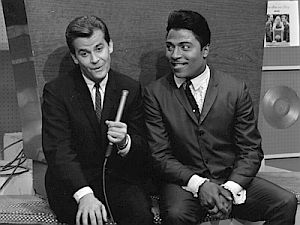
Dick Clark interviewing a young Little Richard on American Bandstand sometime in 1963 or 1964. Click for 'Best Of' CD.
The 1963 season, in any case, was the last year that American Bandstand would be broadcast from Philadelphia. In early 1963, the live broadcasts were replaced by previously-taped shows, though still running five days a week. In August, Bandstand ended its weekday broadcasts and instead, went to a Saturdays-only show for one hour, ending its years in Philadelphia with its final broadcasts in December 1963. By February 1964, the show resumed broadcasting from Los Angeles, California, near Hollywood. Clark by then had also been serving as a game show host, a part of his career that would grow in the years ahead. At the time of Bandstand’s move west, Dick Clark was still a young man at age 34.
The move to California and the show’s location near the growing music industry in the Los Angeles area, was beneficial in terms of Bandstand landing more musical guests. And in terms of the youth culture at that time, California was becoming an important center of attention.It was “where the action was,” as Clark would later explain. “Everything was going on there. The surfing craze was high on everybody’s list of things to do, whether you lived near water or not. Everybody wanted to have bleached-blonde straight hair… So I figured I’d better get out [there].”
Still, the 1963-1964 period became something of dividing line for Bandstand and the nation. With the assassination of President John F. Kennedy on November 22, 1963, America fell into a period of mourning and national soul-searching. And with the turn of the new year in 1964, the music began to change as well. In February 1964, after the Beatles performed on The Ed Sullivan Show, “Beatlemania” swept the country. Plain Vanilla rock ‘n roll was heading into some new territory, not the least of which would be drug and psychedelic influences.
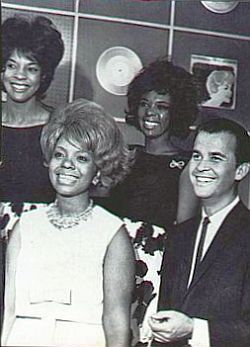
1962: Top left to right - Martha Reeves, Annette Beard, Mary Wells & Dick Clark. Click for Martha & The Vandellas story.
What follows below is a listing of artists who appeared on American Bandstand in 1963 – the final Philadelphia year — along with a few Bandstand “top ten” lists from that year. Artists appearing on Bandstand are listed by date, and in some cases, with the song each performed. Other Bandstand-related stories at this website include, “At the Hop, 1957-1958,” “Bandstand Performers, 1957,” and “American Bandstand, 1956-2007,” a general history of the show, Dick Clark, and his related businesses. Thanks for visiting — and if you like what you find here, please make a donation to help support this website. Thank you. – Jack Doyle.
“American Bandstand”
Selected Guests & Performers
1963
January 1963
Jan 2: D. Warwick- “Don’t Make Me Over”
Jan 4: Johnny Thunder- “Loop de Loop”
Jan 10: B. Lynn- “You’re Gonna Need Me”
Jan 11: Freddy Cannon- “Four Letter Man”
Jan 15: The Dreamlovers
Jan 17: Dion – “Ruby Baby”
Jan 18: Paul & Paula- “Hey Paula”
Jan 22: Barbara Lynn
Jan 23: J. Mathis- “What Will Mary Say?”
Jan 28: Steve Alaimo
Jan 29: Conway Twitty- “The Pickup”
Jan 31: Bobby Comstock & The Counts
February 1963
Feb 1: The Dreamlovers
Feb 4: Bobby Rydell- “Love is Blind”
Feb 6: J. Darren- “Pin A Medal on Joey”
Feb 8: Lou Christie- “The Gypsy Cried”
Feb 12: Sandy Stewart
Feb 14: S. Davis- “End Of The World”
Feb 19: J. Ray- “Look Out, Chattanooga”
Feb 20: Lou Christie- “The Gypsy Cried”
Feb 21: Nancy Sinatra
Feb 22: Four Seasons- “Walk Like A Man”
Feb 24: N. Sedaka- “Alice in Wonderland”
Feb 25: J. Tillotson-“Out of My Mind”
Feb 27: Marcie Blaine
Feb 28: Marcie Blane- “Bobby’s Girl”
March 1963
Mar 1: Four Seasons- “Walk Like a Man”
Mar 5: Bobby Comstock- “Let’s Stomp”
Mar 6: Connie Francis- “Follow the Boys”
Mar 8: Nancy Sinatra- “Like I Do”
Mar 12: Johnny Thunder
Mar 14: Jo Ann Campbell- “Mother…”
Mar 18: Anita Bryant- “Our Winter Love”
Mar 19: Timi Yuro- “Insult to Injury”
Mar 22: Wayne Newton
Mar 26: The Dreamlovers
Mar 28: Wayne Newton- “Heart…”
Mar 29: Jan & Dean- “Linda”
April 1963
Apr 2: B. Vinton- “Over the Mountain”
Apr 12: J. Soul- “If You Wanna Be…”
Apr 17: S. Alaimo- “Lifetime of…”
Apr 18: Al Martino- “I Love You Because”
Apr 19: Johnny Cymbal- “Mr Bass Man”
Apr 23: Bobby Lewis- “Intermission”
Apr 25: Freddy Cannon- “Patty Baby”
Apr 26: Frankie Avalon
May 1963
May 1: Mickey Callan
May 2: Peter, Paul & Mary- “Puff…”
May 3: Jimmy Clanton
May 7: N. Sedaka- “Let’s Go Steady…”
May 8: D. Love- “Today I Met Boy…”
May 14: Rockin’ Rebels
May 24: S. Davis- “…Saving My Love”
May 30: Lesley Gore- “It’s My Party”
May 31: B. Hyland- “…Afraid to Go Home”
June 1963
Jun 5: The Righteous Brothers
Jun 6: Dee Dee Sharp
Jun 7: Essex – “Easier Said Than Done”
Jun 10: Ray Stevens- “Harry The Ape”
Jun 11: Frankie Avalon
Jun 12: Chubby Checker- “Black Cloud”
Jun 13: T. Yuro- “Make the World…”
Jun 14: Bobby Vinton- “Blue on Blue”
Jun 17: Miami Beach Show
Jun 18: Nancy Sinatra- “One Way”
Jun 19: Steve Alaimo
Jun 20: Bill Anderson- “Still”
Jun 21: Guest info unavailable
Jun 26: James Brown- “Prisoner of Love”
Jun 27: Barbara Lewis- “Hello Stranger”
Jun 28: Paul & Paula- “First Quarrel”
July 1963
Jul 3: Dean Randolph- “False Love”
Jul 4: Joey Dee- “Dance, Dance, Dance”
Jul 5: Dee Dee Sharp- “…Cradle of Love”
Jul 8: Stevie Wonder – “Fingertips, Pt 2”
Jul 10: Link Wray- “Jack the Ripper”
Jul 11: Doris Troy
Jul 17: Freddy Cannon
Jul 22: Bobby Vinton
Jul 23: F. Cannon- “Everybody Monkey”
Jul 24: Roy Orbison- “Falling”
Jul 25: B. Hyland- “Afraid to Go Home”
Jul 26: Jimmy Clanton
Jul 29: Patty Duke (Patty Duke Show)
Jul 30: Mel Carter- “When a Boy…”
Jul 31: Frankie Avalon
August 1963
Aug 1: The Dovells- “Betty in Bermudas”
Aug 2: Freddie Scott- “Hey Girl”
Aug 5: Eddie Hodges- “Halfway”
Aug 6: D. D. Sharp- “Rock Me in The…”
Aug 7: Jo Ann Campbell
Aug 8: Wayne Newton- “Danke Schoen”
Aug 9: Steve Alaimo- “Don’t Let Sun…”
Aug 12: Al Martino- “Painted, Tainted…”
Aug 13: Roy Clark- “Tips of My Fingers”
Aug 14: Dick & Dee Dee- “Love is…”
Aug 15: Bandstand Fans Special
Aug 19: Duane Eddy- “… Lonely Guitar”
Aug 22: Dick & Dee Dee
Aug 23: B. Lynn- “…Laura’s Wedding”
Aug 29: Fats Domino- “Red Sails in Sunset”
Aug 30: Final Daily Show- Dick Clark
Bandstand “Top Ten” List
(30 August 1963)
1. “My Boyfriend’s Back!”- The Angels
2. “Hello Mudduh…”- Allan Sherman
3. “Fingertips”- Little Stevie Wonder
4. “Candy Girl”- The 4 Seasons
5. “Blowin’ in Wind”- Peter, Paul & Mary
6. “If I Had A Hammer”- Trini Lopez
7. “Judy’s Turn to Cry”- Lesley Gore
8. “Mockingbird”- Inez & Charlie Foxx
9. “More”- Kai Winding
10.”Denise”- Randy & The Rainbows
September 1963
(Saturday shows begin)
Sep 7: Neil Sedaka- “The Dreamer”
Sep 7: The Jaynetts- “Sally Go…Roses”
Sep 14: Dion- “Donna the Prima Donna”
Sep 14: Major Lance- “Monkey Time”
Sep 21: Skt. Davis- “Can’t Stay Mad…”
Sep 21: Garnett Mimms- “Cry Baby”
Sep 28: B. Rydell- “Let’s Make Love…”
Sep 28: The Ronettes- “Be My Baby”
October 1963
Oct 5: Dee Dee Sharp- “Wild”
Oct 5: Linda Scott- “Let’s Fall in Love”
Oct 12: The Chiffons– “A Love So Fine”
Oct 19: Peggy March- “…Follow Him”
Oct 19: Bill Anderson- “8 x 10”
Oct 26: The Busters- “Bust Out”
Oct 26: Freddy Cannon- “That’s What…”
Bandstand “Top Ten” List
(12 October 1963)
1. “Sugar Shack”- J. Gilmer & Fireballs
2. “Be My Baby”- The Ronettes
3. “Blue Velvet”- Bobby Vinton
4. “Cry Baby”- G. Mimms & Enchanters
5. “Sally, Go ‘Round…”- The Jaynetts
6. “Busted”- Ray Charles
7. “My Boyfriend’s Back”- The Angels
8. “Mean Woman Blues”- Roy Orbison
9. “Heat Wave”- Martha & Vandellas
10. “Donna the Prima Donna”- Dion
November 1963
Nov 2: Dale & Grace- “…Up to You”
Nov 2: Wayne Newton- “Shirl Girl”
Nov 9: Gene Pitney- “24 Hrs From Tulsa”
Nov 9: Sunny & Sunglows- “Talk to Me”
Nov 16: Bobby Bare- “500 Miles…”
Nov 16: Brian Hyland- “Let Us Make…”
Nov 30: Dick Clark’s Celebrity Party
December 1963
Dec 7: Neil Sedaka – “Bad Girl”
Dec 7: Vito & Salutations- “Unchained…”
Dec 7: Chubby Checker- “Hooka Tooka”
Dec 21: Chubby Checker- “Lody Lo”
Dec 21: Donald Jenkins- “Adios”
Dec 28: Bobby Vinton- “Blue Velvet”
Dec 28: Patty Duke- Dick Clark interview
Bandstand “Top Ten” List
(21 December 1963)
1. “Dominique”- The Singing Nun
2. “Louie Louie”- The Kingsmen
3. “Don’t Have to Be a…” – Caravelles
4. “There! I Said it Again”- Bobby Vinton
5. “Since I Fell for You”- Lenny Welch
6. “Be True to Your School”- Beach Boys
7. “Drip Drop”- Dion
8. “…Leaving it Up to You” – Dale & Grace
9. “Everybody” – Tommy Roe
10. “Popsicles & Icicles” – The Murmaids
______________________________
Note: This is not a complete list of all
1963 American Bandstand guests, as some
dates, artists and/or songs are missing.
Available sources have incomplete,
conflicting, or uncertain information.
|
Please Support Thank You |
____________________________________
Date Posted: 30 April 2012
Last Update: 6 August 2023
Comments to: jackdoyle47@gmail.com
Twitter: https://twitter.com/PopHistoryDig
Article Citation:
Jack Doyle, “Bandstand Performers: 1963,”
PopHistoryDig.com, April 30, 2012.
____________________________________
Books at Amazon.com…
Sources, Links & Additional Information
John A. Jackson, American Bandstand: Dick Clark and the Making of a Rock ‘n’ Roll Empire, New York: Oxford University Press, 1997.
Associated Press, “‘American Bandstand’ Honored for Its Age,” New York Times, September 16, 1987.
Hank Bordowitz, Turning Points in Rock and Roll, Citadel Press, 2004.
“Dionne Warwick,” in Holly George-Warren and Patricia Romanowski (eds), The Rolling Stone Encyclopedia of Rock & Roll, Rolling Stone Press, New York, 3rd Edition, 2001, pp. 1046-1047.
“Don’t Make Me Over,” Wikipedia.org.
“The Four Seasons,” in Holly George-Warren and Patricia Romanowski (eds), The Rolling Stone Encyclopedia of Rock & Roll, Rolling Stone Press, New York, 3rd Edition, 2001, pp. 346-347.
“The Four Seasons,” Wikipedia.org.
“May 30, 1963: Lesley Gore Sings ‘It’s My Party’ on Bandstand,” History.com.
“Lesley Gore,” Wikipedia.org.
R. Buxton, “Dick Clark,” The Museum of American Broadcast Communications.
“American Bandstand,” The Museum of American Broadcast Communications.
“Dick Clark,” The Radio Hall of Fame.
American Bandstand articles at New York Daily News.
The Essex,”Wikipedia.org.
“Dick Clark Interview with Bobby Darin, 1963,” BobbyDarin.net.
“American Bandstand – Season 6 Episode Guide,” TV.com.
“American Bandstand – Season 7 Episode Guide,” OVGuide.com.
________________________________________________

Among dance shows that Dick Clark did in 1963 was the one photographed above – a “Dick Clark Parade of Stars” show undertaken with CHUM radio in Toronto, Canada on July 19, 1963 at the Maple Leaf Gardens.

